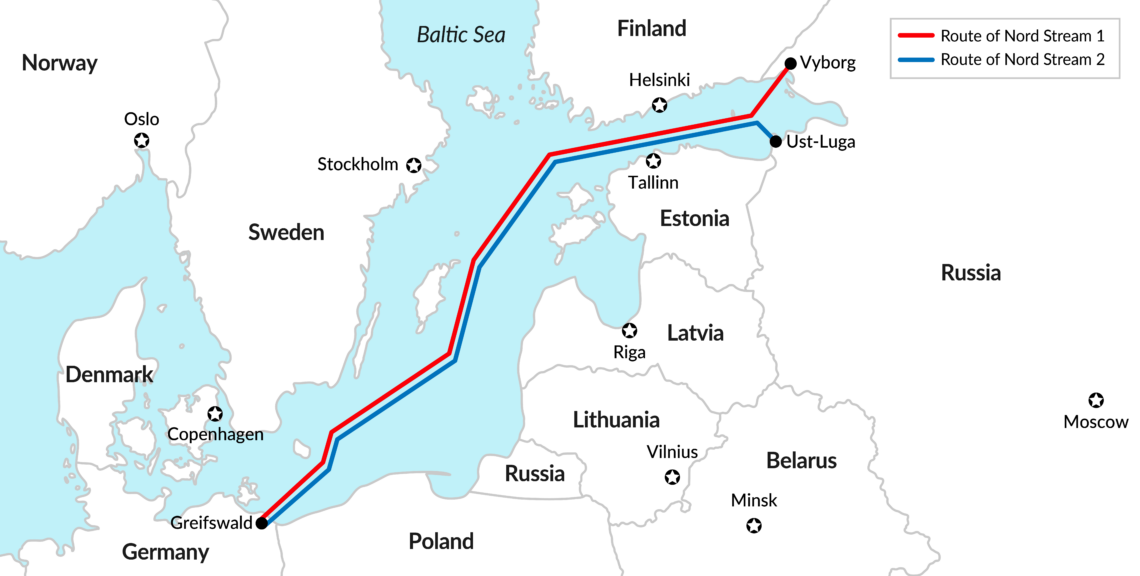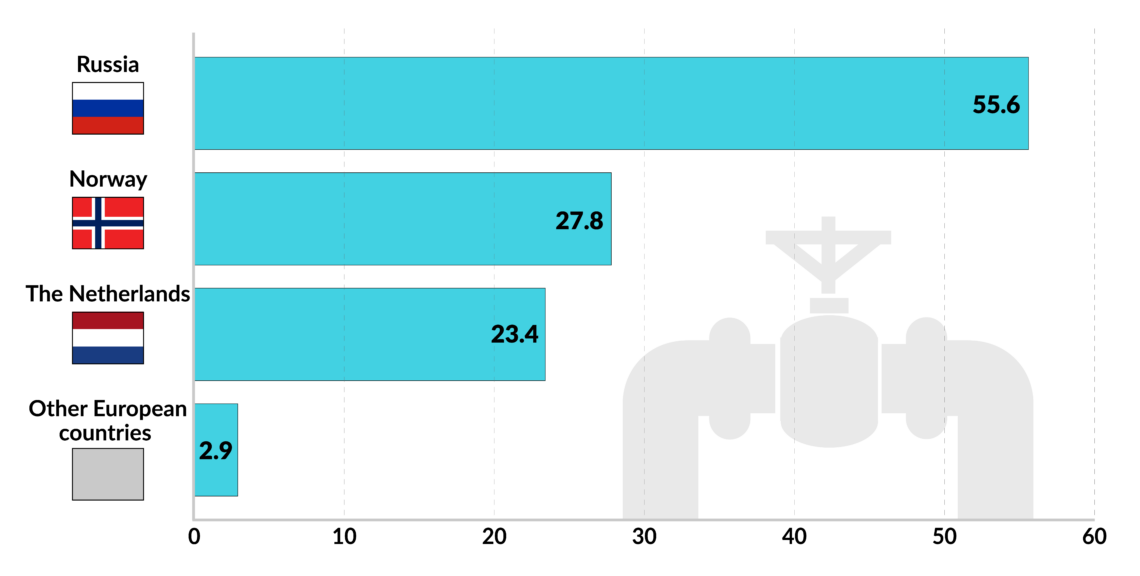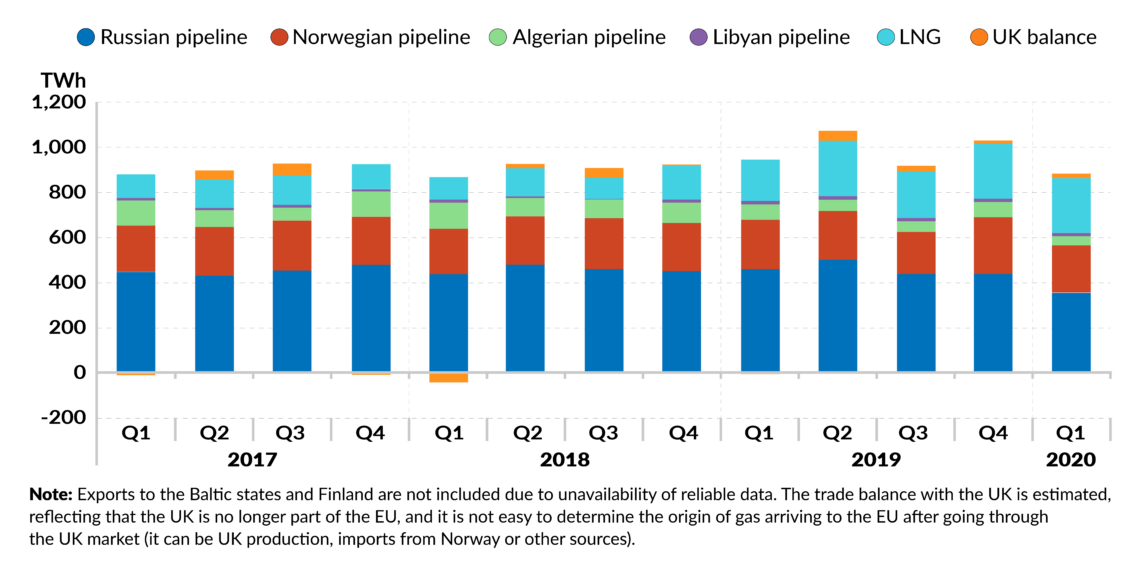Nord Stream 2 divides Germany’s allies
Nord Stream 2 is Europe’s most controversial energy project. In October, the U.S. slapped another set of sanctions on contractors and suppliers building the pipeline, while the pandemic-induced drop in the economy raises doubts about the initiative’s financial viability.

In a nutshell
- Nord Stream 2 offers many risks for Europe’s energy security
- The U.S. and several EU allies oppose the pipeline project
- Recent events increase the chance that it is going to be scrapped
In October, the United States broadened its sanctions targeting the Nord Stream 2 gas pipeline, which is currently being built between Russia and Germany. Announced in 2015, construction on the project is 94 percent complete. However, in December 2019, a Swiss pipe-laying vessel halted its activities on the project due to a new round of U.S. sanctions. Only 165 kilometers of pipe remain to be laid beneath the Baltic Sea.
Outrage in Germany over the poisoning of Russian opposition leader Alexey Navalny in August – widely blamed on the Kremlin – triggered calls to halt the initiative. However, Berlin opted to continue. The project is highly controversial, and could therefore deepen splits both within the EU and between Germany and the U.S.
The American sanctions have focused on the companies that own ships like the above-mentioned Swiss vessel, as well as the firms providing services to them. The goal was to halt the construction of the 11 billion-euro pipeline, which is due to transport gas from Russia to the German coast (the pipeline is actually due to end in Chancellor Angela Merkel’s home constituency in Western Pomerania).
Once complete, Nord Stream 2 would effectively double the volume delivered by its predecessor, Nord Stream 1.
Once complete, Nord Stream 2 would have a capacity of 55 billion cubic meters of gas, effectively doubling the volume delivered by its predecessor, Nord Stream 1. Both have been built to allow Russia to access the German market directly, without pumping gas through pipelines in Ukraine, for which Moscow pays transit fees.
Russia’s only pipe-laying ship, the Akademik Cherskiy, traveled more than 10,000 kilometers from Nakhodka, in Russia’s Far East, to the Russian exclave of Kaliningrad and then the German port of Mukran in the Baltic Sea. There, it was refitted and upgraded, and can now complete construction of Nord Stream 2.
The U.S. Congress is expected to impose additional sanctions by the end of this year. They will target the provision of insurance services to Russian vessels, the operational certification of Nord Stream 2, and other pipeline-construction activities. As the U.S. sees it, the pipeline will increase Europe’s dependence on Russian gas imports and hurt Ukraine by sharply decreasing its transit fees. Washington’s sanctions policy would have more political credibility, however, if it were also willing to restrict rising Russian oil supplies to the U.S., which became the second-largest importer of Russian oil in the first half of 2020.
Facts & figures

At the beginning of October, Poland’s anti-monopoly watchdog demanded that Russian gas giant Gazprom pay a 6.45 billion-euro fine over Nord Stream 2 – the result of an antitrust procedure it launched in 2018. The Polish government agency also slapped another 52 million-euro fine on five European gas companies (Uniper, Wintershall Dea, Royal Dutch Shell, OMV and ENGIE) that were all involved in financing the pipeline. On the other side, however, Denmark has granted the company that operates Nord Stream 2 the final approval it needs to start operations in Danish waters.
The German government has defended the project as merely a commercial initiative that will enhance the security of Europe’s gas supply, while declaring that the U.S. sanctions violate European sovereignty and international law. In August, 24 EU member countries voiced their support for this position, formally expressing their dissatisfaction with the sanctions to the U.S. State Department.
Those sentiments should not be equated with support for Nord Stream 2, which has never had majority support among EU members or the European Parliament. The European Commission has also voiced its opposition to the project.
Facts & figures
EU gas supply balance in 2019
- EU gas consumption: 470 bcm (+2% vs. 2018)
- EU gas production: 101 bcm (-10%)
- Net gas imports: 398 bcm (+8%)
- LNG import capacity: 210 bcm
(29 LNG import terminals in 11 member states) - LNG imports: 108 bcm (+75% / +48 bcm vs. 2018)
= 27% of all EU gas imports - EU LNG import share of global LNG trade: 22.36%
(of 483 bcm)
Source: European Commission
Yet Germany is the EU’s most important member state. Its decision to move ahead with the project in the face of such opposition presents a strategic dilemma for Brussels, other member states and NATO partners. Berlin’s policy on Nord Stream 2 has revealed a remarkable lack of understanding for the strategic interests of its fellow member states – all for what it considers a special German-Russian energy partnership.
New demands to stop the project came with the poisoning of Russian opposition leader Alexey Navalny. Even representatives of the Social Democratic Party (SPD), which has strongly supported Nord Stream 2, questioned whether it could continue. Both Foreign Minister Heiko Maas and the party’s candidate for chancellor, Olaf Scholz, called on Russia to thoroughly investigate the attack. Since many suspect the Kremlin is responsible for the poisoning, that outcome seems unlikely.
Facts & figures
Russian gas exports to Europe in 2019
- via Ukraine: 74 bcm
- via Nord Stream 1: 53 bcm
- via Belarus: 36 bcm
- Total: 163 bcm
Deepening dependence
The construction of Nord Stream 2 will consolidate Germany’s position as a major European gas hub. Russian supplies have increased from about 40 percent of Germany’s gas imports in 2010 to more than 50 percent today. German government agencies no longer publish official Russian gas import volumes or the share of Russian gas supplies as a share of Germany’s total gas imports. The official justification for this move is that the various gas supplies from different countries are mixed within the German pipeline network, and that differentiating between them makes little sense. That explanation rings hollow, however, since Germany still publishes the breakdown of origin for its oil and electricity imports, which can be even more difficult to calculate.
Russian supplies have increased from about 40 percent of Germany’s gas imports in 2010 to more than 50 percent today.
The European Commission and BP do publish such figures, however. According to BP statistics, Germany imported about 109.6 billion cubic meters (bcm) of gas in 2019. Domestically, it produced about 5.3 bcm and consumed 88.7 bcm, leaving 26.2 bcm for export.
Russian pipeline gas accounted for nearly 51 percent of all of Germany’s gas imports. With the completion of Nord Stream 2, some analyses indicate that Russian gas supplies will increase to nearly 60 percent of Germany’s total gas imports – all at a time when political tensions with Moscow are rising.
Nord Stream 2 canceled
Though the German government and the European energy companies involved in Nord Stream 2 may consider it a “commercial project” and nothing more, the same cannot be said for Gazprom, which Russia has used time and again as an instrument of foreign policy.
President Vladimir Putin himself decides in which major pipeline and LNG projects Russian energy companies invest. For years, he blocked any expansion of LNG exports to Europe, since they could compete with Gazprom’s pipeline exports, diminishing their geopolitical usefulness. They are still allowed only to those European countries which do not import Russian pipeline gas from Gazprom.
If the Nord Stream 2 project were to be canceled, it would be in Europe’s and the U.S.’s strategic interest. Europe’s energy diversification policies would be strengthened, and Ukraine would see its transit fees increase. Europe’s energy dependence on Russia would not automatically drop, however. Without Nord Stream 2, Moscow would just pump more supplies through Ukraine.
Facts & figures

In fact, due to the Covid-19 pandemic and its dampening of natural gas demand, Gazprom itself (as directed by the Kremlin) could decide to cancel Nord Stream 2. In May 2018, Russia’s state-owned Sberbank confirmed this author’s previous analysis that “cheap” Russian gas was a myth, putting into question Nord Stream 2’s commercial viability.
The Sberbank report criticized Gazprom for investing in expensive and unprofitable export pipelines such as Power of Siberia, TurkStream and Nord Stream 2. The report also claimed that Nord Stream 2 will not generate any profit for Gazprom over the next 20 years and that only Russian contractors with close ties to the Kremlin would gain from it.
Russia’s total pipeline gas export capacity is 240 bcm a year, which is augmented by rising LNG exports to Europe. Nord Stream 2 would expand that to nearly 300 bcm. Yet in 2019, its gas exports to Europe and Turkey totaled just 199 bcm.
For years, an oversupply of gas has meant a global buyer’s market. Moreover, Europe has set in motion ambitious plans for decarbonization that will see its demand for conventional gas imports rapidly decline after 2030. Considering all this, and the fact that Nord Stream 2 will require more than 20 years to be profitable even in an environment of high exports and gas prices, the project looks commercially questionable indeed.
Russia may soon be unable to afford its heavily subsidized pipelines.
Also, Russia may soon be unable to afford its heavily subsidized pipelines – coping as it is with the economic challenges of sanctions, the pandemic and general stagnation. In the first seven months of 2020, Germany imported 6.4 percent less gas year-on-year, while gas prices also further declined by a third. Gazprom itself predicts its total gas exports to Europe and Turkey to fall to 170 bcm this year. Some analysts even expect a decline to 150 bcm.
Nord Stream 2 completed
Unlike the United Kingdom, France and the Netherlands, Germany has no national energy champion that competes on a global scale. For that reason, Berlin has always been eager to maintain a reputation as a reliable investment market with a stable regulatory framework. Given the manifold uncertainties presented by Germany’s ambitious ongoing energy transition, known as the Energiewende, it needs foreign investments in the sector more than ever. Furthermore, according to the European Energy Charter of 1994, the government would have to pay billions of euros in compensation to companies that have already made investments in the country if projects are terminated or otherwise harmed by state action.
Some argue that Nord Stream 2’s completion could actually enhance European energy security, simply by providing more gas and liquidity to the market. However, that reasoning is undermined by the fact that it would concentrate a huge share of gas imports to Europe (110 bcm of both Nord Stream 1 and Nord Stream 2 against Russia’s 163 bcm to the EU in total in 2019) along just one route. This “route concentration” is the opposite of “route diversification” that helps ensure supply security.
In 2019, the EU imported 41 percent of its gas through Russian pipelines. Including LNG imports from Novatek and Rosneft, Russia accounted for 44 percent of all European gas imports. In the first quarter of 2020, that share rose further, to 46 percent.
Still, completing Nord Stream 2 will not decrease the EU’s energy security. The bloc has numerous other options. It is building new gas interconnectors between member states, creating reverse-flow capabilities and liberalizing its energy market further through revisions to legislation. It is also building import pipelines from new suppliers, like Azerbaijan, through the TANAP-TAP network and building new LNG import terminals. Considering all this, the EU’s energy supply security has increased greatly since 2010.
Compromise with the U.S.
In the U.S. Congress, the strong opposition against Nord Stream 2 is bipartisan, and had emerged even under the administration of former President Barack Obama – it long predates any discussion of American LNG exports to Europe.
In August 2020, the German government proposed a compromise by which it would provide 1 billion euros in subsidies toward building two LNG import terminals in exchange for the U.S. lifting its sanctions on Nord Stream 2. The Trump administration was not interested in the deal.
If Democratic candidate Joe Biden wins the presidential election, his administration might be receptive to a similar offer. He may decide that the LNG terminals would give the U.S. imports a boost in competing on the European market.
Strategic perspectives
The cancellation of Nord Stream 2 would not threaten Germany’s or the EU’s energy security. First, Nord Stream 2 merely allows Russia to circumvent Ukraine. Gazprom can pump increased gas supplies through existing pipelines there, if necessary. Second, Europe has sufficient alternative import options, including LNG from the U.S., Africa and the Middle East, which is not all that much more expensive than pipeline gas from Russia.
In fact, the completion of Nord Stream 2 would lock in dependence on the Baltic Sea route – a point frequently overlooked in the European debate around the pipeline. Though the EU is likely to import far less Russian gas after 2030 due to EU decarbonization efforts, Nord Stream 2 could transport hydrogen instead. Germany’s dependence on natural gas would simply be replaced by a reliance on hydrogen. Gazprom and its German partners are already preparing for this eventuality.
Germany’s hydrogen strategy, published this past June, points to Ukraine and Morocco as potential partners and providers of the fuel. Berlin knows that involving Russia in its plans could invite controversy. But just as they did with Nord Stream 2, Gazprom and the German gas companies may push forward with hydrogen projects anyway, creating faits accomplis.
Regardless of whether Nord Stream 2 is completed or not, the project has become the biggest geopolitical and diplomatic disaster of Angela Merkel’s chancellorship. It has caused lasting damage to allies’ trust in Germany, and will be a future foreign, energy and security policy challenge for her successors.


